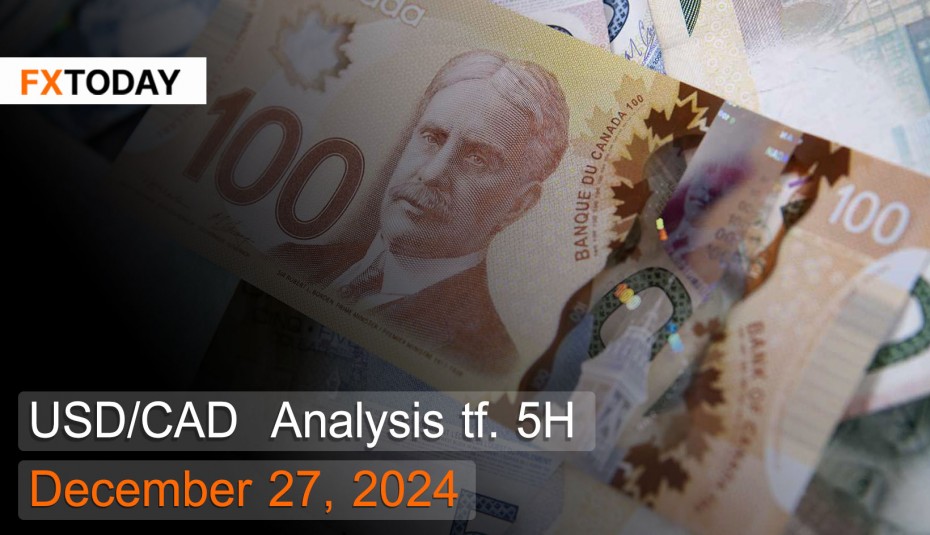Investors eye Bank of Canada's comments in the coming year.
The Canadian dollar weakened to 1.44 against the US dollar, marking its sharpest decline since 2020, as investors closely monitor weak GDP data. Meanwhile, the US dollar has strengthened rapidly. Canada's GDP, expected to contract by 0.1%, is a driving factor that supports investor expectations that the Bank of Canada may need to cut interest rates further by 2025 to stimulate the still-fragile domestic economy. Additionally, pressure from the United States regarding tariff adjustments has forced Canada, a key trade partner, to adapt further to maintain trade relations.
The Canadian raw material price index dropped 0.5% month-over-month in November, following a 4.0% increase in October. This decline was led by a 2.2% drop in energy-related products, with crude oil showing the steepest decline at 2.7%. However, metal ore prices rose sharply by 36.9% year-over-year, particularly for gold, silver, and platinum, which could lead to higher raw material costs in the manufacturing sector.
Canada's GDP contracted by 0.1% month-over-month in November due to reduced output across several industries and weakening external demand. Additionally, issues with household spending have impacted corporate profits. However, rapid growth in the services sector, particularly in food services, real estate, and rental services, prompted the Bank of Canada to revise its GDP growth forecasts to 1.7% for 2025 (down from 1.9%) and 2.1% for 2026 (down from 2.2%), reflecting a slowdown in the domestic economy.
Retail sales in Canada remained unchanged in November from the previous month, following a 0.6% increase in October. The prior month’s growth was driven by sales in motor vehicles and auto parts, including a slight increase in used cars. Meanwhile, sales at gas stations declined for the sixth consecutive month, as did sales of food and beverages, with lower supermarket sales affecting overall retail figures.
The yield on Canada’s 10-year government bond fell to 3.28%, aligning with the drop in US Treasury yields due to weaker-than-expected inflation data. However, core inflation in November stood at 2.7%, higher than the forecasted 2.5%, potentially delaying further rate cuts by the Bank of Canada. Recently, the Bank of Canada reduced its policy interest rate by 50 basis points to 3.25%, amid rising unemployment and sluggish growth. This reflects its effort to balance a slowing economy with persistent inflation. The rate cut widened the yield spread between US and Canadian government bonds.
Techical analysis data (5H)
Resistance: 1.4413, 1.4431, 1.445
Source: Investing.com
Buy/Long 1: If the price touches support in the price range of 1.4357 - 1.4376 but cannot break the support at 1.4376, you may set a TP at approximately 1.4431 and SL at around 1.4339 or according to your acceptable risk.
Buy/Long 2: If the price breaks the resistance in the price range of 1.4413 - 1.4431, you may set a TP at approximately 1.445 and SL at around 1.4357 or according to your acceptable risk.
Sell/Short 1: If the price touches resistance in the price range of 1.4413 - 1.4431 but cannot break the resistance at 1.4413, you may set a TP at approximately 1.4357 and SL at around 1.445 or according to your acceptable risk.
Sell/Short 2: If the price breaks the support in the price range of 1.4357 - 1.4376, you may set a TP at approximately 1.4339 and SL at around 1.4431 or according to your acceptable risk.
Pivot pointDecember 27, 2024 09:39 PM. GMT+7
|
Name
|
S3
|
S2
|
S1
|
Pivot Points
|
R1
|
R2
|
R3
|
|---|---|---|---|---|---|---|---|
| Classic | 1.4339 | 1.4357 | 1.4376 | 1.4394 | 1.4413 | 1.4431 | 1.445 |
| Fibonacci | 1.4357 | 1.4371 | 1.438 | 1.4394 | 1.4408 | 1.4417 | 1.4431 |
| Camarilla | 1.4384 | 1.4387 | 1.4391 | 1.4394 | 1.4397 | 1.4401 | 1.4404 |
| Woodie's | 1.4339 | 1.4357 | 1.4376 | 1.4394 | 1.4413 | 1.4431 | 1.445 |
| DeMark's | - | - | 1.4366 | 1.4389 | 1.4403 | - | - |
















